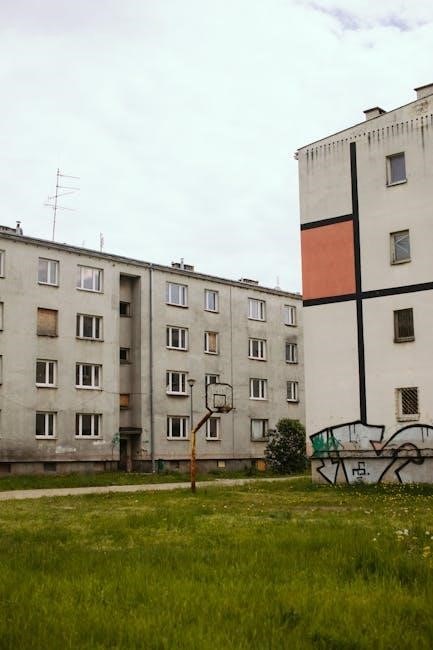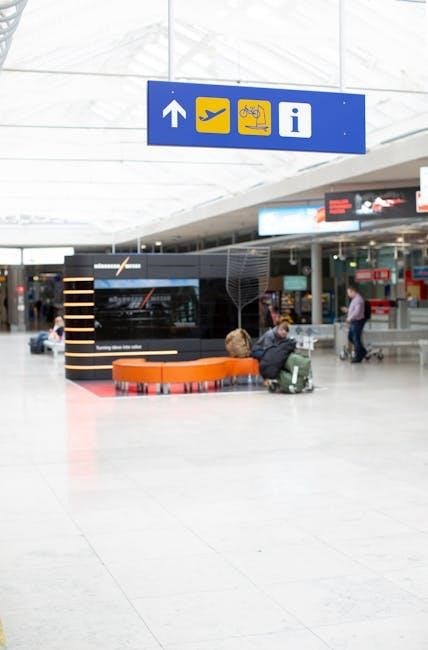Public housing in WA provides affordable rental options for those in need, managed by the Department of Communities. This guide explores eligibility, application processes, and benefits, helping navigate the system and access resources effectively.
1.1 Overview of Public Housing in Western Australia
Public housing in Western Australia is managed by the Department of Communities, offering affordable rental accommodations to eligible households. These dwellings cater to diverse groups, including low-income families, individuals experiencing homelessness, and those with disabilities or financial hardships. The program aims to provide stable housing options, addressing social and economic challenges faced by vulnerable populations.
The public housing portfolio in WA includes a range of properties across metropolitan and regional areas. As of recent data, the average wait time for public housing has been around 100 weeks, with over 16,000 applications on the waiting list. This highlights the demand for affordable housing solutions in the state. For detailed insights, download the PDF guide on public housing waiting list areas in WA.
1.2 Importance of Waiting Lists in Public Housing

Waiting lists for public housing in Western Australia are essential for managing demand and ensuring equitable access to affordable housing. They allow authorities to prioritize applicants based on urgency and need, ensuring those in critical situations receive timely assistance. The waiting list system also helps allocate limited housing resources efficiently, balancing supply and demand across different regions. By maintaining a structured queue, it reduces chaos and provides transparency to applicants. Additionally, waiting lists enable the government to monitor housing demand trends, helping to plan future developments and allocate resources effectively. This system is vital for maintaining fairness and accountability in public housing allocation.
For more details, refer to the PDF guide on public housing waiting list areas in WA.
1.3 Purpose of the Article
This article aims to provide a comprehensive guide to understanding public housing waiting list areas in Western Australia. It seeks to clarify the eligibility criteria, application processes, and management of waiting lists for those seeking affordable housing. By exploring key regions, historical context, and special considerations, the article helps applicants navigate the system effectively. It also highlights the benefits and challenges of public housing programs, offering insights into future developments. The goal is to empower readers with knowledge, enabling them to make informed decisions about their housing needs. For detailed information, the article encourages readers to explore the accompanying PDF guide, which offers in-depth resources and additional support.

Understanding Public Housing Waiting List Areas in WA
This section explains the definition and regional distribution of public housing waiting list areas in WA, aiding applicants in understanding resource allocation and equitable access.
2.1 Definition of Public Housing Waiting List Areas
Public housing waiting list areas in WA refer to designated regions where applicants are prioritized for housing based on eligibility, demand, and regional needs. These areas are defined by the Department of Communities to ensure equitable access to affordable housing. They are typically categorized based on factors like housing shortages, population density, and socioeconomic conditions. Applicants are placed on waiting lists specific to these areas, allowing local housing authorities to manage allocations effectively. The definition helps in identifying priority groups and ensuring resources are distributed where they are needed most. Understanding these areas is crucial for applicants to navigate the system and improve their chances of securing housing.
2.2 Key Regions Covered in WA
Western Australia’s public housing waiting list areas cover a diverse range of regions, reflecting the state’s vast geography and population distribution. Key regions include metropolitan Perth, where demand for housing is highest, as well as regional areas like Peel, South West, and Great Southern. Remote areas such as the Kimberley and Pilbara are also included, addressing the unique housing challenges faced in these locations. Each region is prioritized based on local housing needs, population growth, and socioeconomic factors. The Department of Communities manages these regions to ensure equitable access to public housing. Understanding these areas helps applicants identify where demand is highest and where they may be eligible for priority placement.
2.3 Historical Context of Public Housing in WA
Public housing in Western Australia has a long history, dating back to the post-World War II era when there was a significant shortage of affordable housing. The state government established programs to address this shortage, focusing on providing secure and affordable housing for low-income families, veterans, and vulnerable populations. Over the years, public housing has evolved to meet changing social and economic needs. Key milestones include the expansion of housing stock in the 1970s and reforms in the 1990s aimed at improving tenant outcomes. Today, public housing remains a critical component of WA’s social safety net, with ongoing efforts to modernize and increase the availability of housing options across the state.
Eligibility Criteria for Public Housing Waiting Lists in WA
Eligibility for public housing in WA involves income limits, residency requirements, and prioritization based on need, ensuring equitable access for low-income individuals and families.
3.1 Income Limits and Financial Eligibility

Eligibility for public housing in WA is primarily determined by income limits, which vary based on household size and circumstances. Applicants must demonstrate financial need, with gross income thresholds set by the Department of Communities. For example, single persons, couples, and families with dependents have specific income caps to qualify. These limits ensure housing support is targeted to those who need it most. Additionally, assets may be assessed, though exemptions apply for essential items like a family home. Meeting these financial criteria is the first step in accessing public housing, ensuring resources are allocated fairly and effectively.

3.2 Residency Requirements
Residency requirements are essential for eligibility to public housing in WA. Applicants must be Australian citizens, permanent residents, or hold a valid visa granting long-term stay. They must also demonstrate a genuine need to live in a specific area, often due to family ties, employment, or medical reasons. Proof of residency, such as utility bills or rental agreements, is typically required. Special considerations may apply for Indigenous communities or those experiencing homelessness; These requirements ensure housing support is prioritized for individuals with strong connections to the region, aligning resources with community needs while maintaining fairness in the allocation process. Meeting residency criteria is a critical step toward securing a place on the public housing waiting list in WA.
3.3 Special Needs and Prioritization

Special needs and prioritization play a crucial role in managing WA’s public housing waiting lists. Applicants with disabilities, medical conditions, or experiencing homelessness are often given higher priority. Additional considerations are made for victims of domestic violence, elderly individuals, and those facing urgent housing insecurity. The Department of Communities assesses these cases to ensure vulnerable populations receive timely support. Prioritization is based on the severity of need and alignment with housing allocation policies. This system aims to address critical situations promptly while maintaining fairness for all applicants. Special needs assessments may require additional documentation, such as medical certificates or evidence of hardship, to validate priority status. This approach ensures resources are directed to those most in need, balancing equity and urgency effectively.
Application Process for Public Housing Waiting Lists in WA
The application process involves submitting an online form or contacting local housing authorities. Applicants must provide personal and financial details. The Department reviews applications and contacts applicants regarding eligibility and next steps.
4.1 How to Apply for Public Housing
To apply for public housing in Western Australia, visit the Department of Communities website and complete the online application form. Create an account, fill in personal details, and submit. Applications can also be made in person at a local office or by mail. Ensure all required fields are completed accurately to avoid delays. Once submitted, the application is reviewed for eligibility. Applicants may be contacted for additional information. Processing times vary, but updates can be requested through the online portal or by contacting housing authorities directly.
Applicants are encouraged to check the status of their application regularly and update their details if circumstances change.
4.2 Required Documentation
To apply for public housing in Western Australia, specific documentation is required to assess eligibility. Applicants must provide proof of identity, such as a driver’s license or passport, and evidence of income, including payslips or Centrelink statements. Residency status, like citizenship or visa documents, must also be submitted. Asset declarations, such as bank statements, are needed to evaluate financial eligibility. Additional documents may include birth certificates for dependents and medical certificates for special needs. Applicants should ensure all documents are current and valid. Submitting complete and accurate documentation helps streamline the process.
It is essential to retain copies of all submitted documents for personal records.
4.3 Role of Local Housing Authorities
Local housing authorities in Western Australia play a crucial role in managing public housing applications and waiting lists. They are responsible for processing applications, verifying eligibility, and prioritizing applicants based on need. These authorities also maintain and update waiting lists, ensuring transparency and fairness. They provide guidance to applicants, address queries, and offer support throughout the process. Local housing authorities work closely with state agencies to allocate housing units efficiently. Their role extends to conducting regular reviews of applications and adapting to changing housing demands. By streamlining operations, they aim to reduce wait times and improve access to affordable housing for those in need. Their efforts are vital in addressing housing shortages and supporting vulnerable communities.
Managing the Public Housing Waiting List in WA

Managing the public housing waiting list in WA involves assessing eligibility, prioritizing applicants, and ensuring transparency. Authorities regularly review and update the list to reflect changing needs and allocate housing fairly.
5.1 Prioritization of Applicants
Prioritization of applicants for public housing in WA is based on urgency and need. Vulnerable groups, such as those experiencing homelessness or domestic violence, are given higher priority; Income levels, family size, and special needs are also considered. Applicants with disabilities or medical conditions requiring adapted housing are often fast-tracked. The system aims to balance fairness with urgency, ensuring those in critical situations receive timely assistance. Local housing authorities assess each case individually, using standardized criteria to maintain equity. This approach helps address the most pressing housing needs while managing the overall demand for public housing in WA. Regular reviews ensure the system remains responsive to community needs and evolving circumstances.
5.2 Average Wait Times and Trends
The average wait times for public housing in WA vary significantly based on location and housing type. In metropolitan areas like Perth, waits can range from 6 months to several years, while regional areas may experience shorter wait times due to lower demand. Trends show increasing demand for public housing, leading to longer waiting periods. The Department of Communities regularly updates wait time estimates, reflecting population growth and housing shortages. Priority applicants, such as those facing homelessness or domestic violence, often bypass standard wait times. Overall, wait times remain a challenge, highlighting the need for additional housing solutions to meet growing demand across WA.
5.3 Updates and Changes to the Waiting List
The WA Department of Communities regularly updates the public housing waiting list to ensure accuracy and fairness. These updates reflect changes in applicants’ circumstances, such as income fluctuations or family size. The department may also implement policy changes to improve waitlist management. Applicants are notified of significant updates, ensuring transparency throughout the process. Additionally, the department reviews and adjusts waitlist priorities based on emerging needs and housing availability. These adjustments aim to address urgent cases and optimize housing allocations. Applicants are encouraged to keep their information up-to-date to avoid delays. Regular updates ensure the waitlist remains dynamic, adapting to the evolving needs of communities across Western Australia.

Special Considerations for Public Housing in WA
Western Australia prioritizes Indigenous housing needs and remote area challenges, ensuring tailored support for vulnerable groups and regional communities.
6.1 Preferences for Vulnerable Populations
In Western Australia, public housing policies prioritize vulnerable populations, including Indigenous communities, the elderly, and those with disabilities. These groups often face significant barriers to secure housing and require tailored support. The Department of Communities implements specific measures to address their needs, such as streamlined applications and partnerships with support services. Indigenous applicants, in particular, are given priority due to historical disadvantages. Additionally, individuals experiencing homelessness or fleeing domestic violence receive urgent consideration. These preferences aim to ensure equitable access to housing and reduce social inequality. By addressing the unique challenges of vulnerable populations, WA’s public housing system strives to create a safer and more inclusive community for all residents.
6.2 Impact of Criminal History on Housing Applications

A criminal history can significantly impact public housing applications in Western Australia. The Department of Communities assesses each case individually, considering the nature and severity of offenses. Recent or serious crimes, such as violent offenses, may lead to exclusion or lower priority on the waiting list. However, minor offenses or older convictions may not automatically disqualify applicants. The Housing Authority also evaluates the applicant’s current circumstances and any evidence of rehabilitation. This balanced approach aims to uphold public safety while providing opportunities for individuals to reintegrate into society. Applicants with criminal histories are encouraged to provide additional context or supporting documents to aid in the decision-making process. This ensures fairness and aligns with legal and policy requirements.
6.3 Addressing Homelessness Through Public Housing
Public housing plays a pivotal role in addressing homelessness in Western Australia by providing stable and affordable accommodation. The state’s housing programs prioritize individuals and families experiencing homelessness, offering them a pathway to secure housing. Rapid rehousing initiatives and support services are often integrated into public housing solutions to help tenants achieve long-term stability. The Department of Communities works closely with homelessness service providers to identify and assist those in need. While public housing is a critical tool in reducing homelessness, demand often exceeds supply, highlighting the need for continued investment and innovative solutions. These efforts aim to ensure vulnerable populations have access to safe and secure housing options.

Benefits and Challenges of Public Housing Waiting Lists in WA
Public housing provides affordable shelter but faces challenges like long waitlists and limited stock. While it supports vulnerable populations, applicants often experience delays and administrative complexities.
7.1 Advantages of Public Housing Programs
Public housing programs in Western Australia offer numerous benefits, providing affordable and secure housing options for low-income individuals and families. One key advantage is the provision of rent subsidies, ensuring that housing costs remain manageable. Additionally, public housing often includes access to essential services and support programs, helping residents achieve stability and improve their quality of life. These programs also play a critical role in reducing homelessness by offering a safety net for vulnerable populations. Furthermore, public housing fosters community integration, as residents can access shared facilities and resources. Overall, these programs are vital for addressing housing affordability and social inequality in WA.
7.2 Challenges Faced by Applicants
Applicants for public housing in Western Australia often encounter significant challenges when navigating the waiting list system. One major issue is the lengthy wait times, which can exceed several years in high-demand areas. This prolonged waiting period can exacerbate housing insecurity, particularly for vulnerable populations. Additionally, the limited availability of public housing units compared to the number of applicants creates intense competition, making it difficult for many to secure a place. The complexity of the application process, including stringent eligibility criteria and required documentation, can also act as a barrier for some individuals. Furthermore, the lack of transparency in waitlist prioritization and updates can leave applicants feeling uncertain and frustrated about their housing prospects.
7.3 Future Outlook for Public Housing in WA
The future of public housing in Western Australia looks promising, with a focus on addressing growing demand and improving accessibility. The state government has committed to increasing funding for public housing, aiming to reduce wait times and expand affordable housing options. Emphasis is being placed on sustainable and modern housing designs to meet the needs of diverse communities. Additionally, there are plans to integrate technology, such as online portals, to streamline applications and improve transparency. However, challenges like funding constraints and construction delays may impact progress. Despite these hurdles, the outlook remains positive, with a strong emphasis on partnerships between government, community groups, and private sectors to deliver innovative housing solutions.
8.1 Summary of Key Points
This article provides a comprehensive overview of public housing waiting list areas in Western Australia (WA). It explores the eligibility criteria, application processes, and management of waiting lists. Key points include income limits, residency requirements, and prioritization for vulnerable populations. The article also discusses the role of local housing authorities and the challenges faced by applicants. Average wait times and trends are highlighted, along with special considerations like criminal history and homelessness. The benefits of public housing programs are balanced with the challenges, offering a realistic outlook. Finally, the guide encourages readers to explore the PDF resource for detailed information and additional support. This summary encapsulates the essential aspects of public housing in WA, ensuring a clear understanding for those seeking assistance.
8.2 Final Thoughts on Public Housing Waiting Lists in WA
Public housing in Western Australia plays a vital role in providing affordable shelter to those in need, with waiting lists serving as a crucial pathway for access. While the system faces challenges such as long wait times and high demand, efforts to improve efficiency and prioritization are ongoing. Prospective applicants are encouraged to stay informed about eligibility criteria and application processes to navigate the system effectively. By understanding the requirements and staying engaged, individuals can better position themselves for housing opportunities. Additionally, exploring resources like the public housing waiting list areas WA PDF guide can provide valuable insights and updates. Patience and persistence are key as the state continues to address housing needs and strive for a fair and transparent system.
8.3 Encouragement to Explore the PDF Guide
For those seeking detailed insights into public housing waiting list areas in Western Australia, the accompanying PDF guide is an invaluable resource. Packed with comprehensive information, it provides a deeper dive into eligibility criteria, application processes, and regional-specific details. The guide includes visual maps, infographics, and practical tips to help navigate the system effectively. Whether you’re a first-time applicant or seeking to understand your place on the waiting list, this PDF offers clarity and guidance; It also highlights key contacts and resources for further assistance. Download the guide today to empower yourself with the knowledge needed to secure affordable housing in WA.
This resource is designed to be your go-to companion for all public housing-related queries.

Be First to Comment